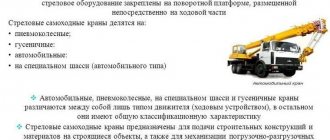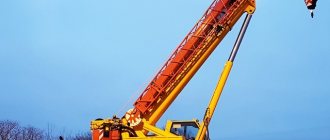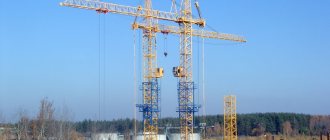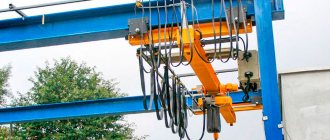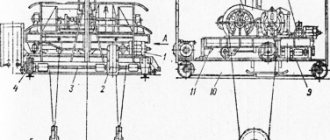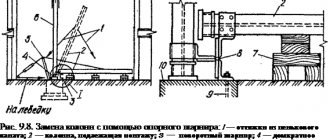An industrial safety examination (ISA) of lifting cranes allows one to assess their actual condition and compliance with current requirements, when technical regulations do not provide for another form of assessment. Its implementation is available only to those organizations that have a new Rostechnadzor license.
Our company not only has a reissued license, but also experts certified according to the new requirements who are ready to competently and efficiently carry out industrial safety inspections in order to save your time and money by reducing the risks of accidents associated with the operation of cranes with an expiring design period of safe operation.
If you are interested in general information, go to the industrial safety examination section.
Cranes are objects of electrical safety equipment
According to Rostechnadzor order No. 533 dated November 12, 2013 and technical regulations TR CU 010/2011, cranes are divided into those subject to and those not subject to industrial safety examination.
Cranes requiring electrical inspection:
- All lifting types (tower, gantry and others):
- manipulators;
- lifts used in construction;
- excavator cranes limited to working with a hook suspended by a rope or electromagnets;
- replaceable load-handling devices and devices (grabs, traverses, grips, slings, etc.);
- removable cabins and cradles used for moving people.
Cranes that do not require electrical inspection:
- bridge and cantilever type with a lifting capacity of up to 10 tons inclusive,
- boom type with lifting capacity up to 1 t inclusive;
- boom type with constant reach or without a rotating mechanism;
- mobile cranes installed on the erected structure;
- used as simulators at training grounds;
- installed on technological machines and used exclusively for the purpose of their repair;
- manipulators installed on the foundation and manipulators with a lifting capacity of up to 1 t. or with a load moment of up to 4 t. m inclusive;
- freight lifts for construction;
- overhead stacker cranes;
- pipe-laying cranes.
Cranes whose scope of application is related to the defense interests of the state and its security are not subject to EPB; nuclear energy (excluding substations for general industrial purposes); manually operated lifting devices (elevators, cable cars, tow trucks, funiculars and others); with installation in mines, on ships and other watercraft; with work that excludes the use of load-handling devices.
WE APPOINT A RESPONSIBLE AND ENSURE PROPER OPERATION
We successfully allowed an employee of a working profession - a slinger - to work. Now, as for the requirements for the maintenance of equipment and everything related to safety when working with it, state regulatory labor protection requirements must be met: production equipment must ensure the safety of workers during installation (dismantling), commissioning and operation, as in the case of autonomous use , and as part of technological complexes, subject to the requirements (conditions, rules) provided for by the operational documentation[15].
Operational documentation is, first of all, a crane operating manual along with manuals for its components. In them we find the procedure for inspections and the frequency of technical examinations required to ensure safety.
If necessary, they indicate parts subject to wear and criteria for their replacement (Fig. 4).
We develop and approve a schedule for inspection activities.
As you can see, in paragraph 8.1 of the Stahl crane operating manual (instructions) there is a control and maintenance table with a detailed description of the frequency of all checks in order to maintain trouble-free operation of the crane. Based on this, we develop our schedule of inspection activities.
We prepare the necessary inspection and condition check logs.
The results of regular checks are reflected in the logs:
- inspection of the condition of load-lifting cranes (hoists, overhead cranes; example 4);
- recording and checking the condition of lifting devices and containers[16] (example 5).
We appoint a person in charge and develop a job description.
By order of the organization, we appoint a person responsible for maintaining the crane in good condition and safe performance of work using PS (example 6), and also developing a job description based on the Standard Instructions for engineering and technical workers responsible for maintaining lifting machines in good condition [17] .
The person responsible for maintaining the PS in working order and for the safe performance of work using the PS must be certified by the organization’s commission or Rostechnadzor.
If the manual (instructions) for the operation of the substation does not contain instructions for conducting a technical examination, we carry it out in accordance with Section. “Technical examination of PS” FNP PS. In addition, regarding the operation of the substation, we also apply other requirements of the FNP of the substation, for example, requirements for installation, commissioning of the substation, etc.
Cases requiring examination
Cranes classified as hazardous production facilities are subject to Federal Law No. 116. In accordance with its provisions, their EPB is carried out:
- Before starting operation;
- Before using lifting structures intended for their own needs at hazardous production facilities;
- Upon completion of the design period or when exceeding the load cycles established by the manufacturer and specified in the technical passport of the facility;
- In the absence of an estimated service life, if in fact the object has been in operation for more than 20 years;
- After structural changes to an object or replacement of materials of its supporting elements;
- After refurbishment and elimination of malfunctions that arose due to an accident at a hazardous production facility.
WE COMPLETE DOCUMENTATION TO PUT THE GPM INTO OPERATION
The only document for putting into operation is the FNP PS - the process of putting the gas and hydraulic machine into operation is established in clauses 138–144 of the FNP PS. Let's consider its stages.
We are creating a commission to make a decision on putting the crane into operation.
The commission should include:
- head of the operating organization;
- chief specialists (chief engineer, technical director, power engineer, mechanic);
- occupational safety specialist.
Representatives of specialized organizations that carried out the installation may participate in the work of the commission.
2. We approve the commission by order of the organization.
Example 1 provides a sample order.
We issue a commissioning certificate.
The results of compliance with the requirements of TR TS 010/2011 and the requirements set out in the manual (instructions) for the operation of the substation are documented in a commissioning certificate (example 2).
What to do at the preparation stage
In the process of preparing for the electrical safety test, the customer provides the expert company with a technical passport and information about the parameters of the lifting mechanism under study. He also issues an internal order to conduct an industrial safety inspection, indicating the persons responsible for safety precautions and ensuring control over the quality of the proposed work. The customer prepares a package of documents, which, in addition to the registration certificate, includes:
- A valid certificate of commissioning of the crane track;
- Previous act of leveling crane tracks, as well as checking insulation (if any);
- Documents related to repair or reconstruction, metal certificates, if used;
- A certificate about the nature of the work performed by the object under study;
- A log containing information about current repairs and maintenance;
- Manual and other documents on the operation of the gas and hydraulic machine;
- Acts and conclusions of previous examinations.
In addition to the documents, the owner of the crane or the company using it prepares the crane and loads for testing for the period of the industrial inspection and allocates an experienced operator of the lifting machine.
Technical examination
All load-lifting cranes and load-handling devices that are subject to industrial safety rules are subject to periodic inspection in accordance with the requirements of regulatory documentation of the Russian Federation.
Technical inspection of lifting machines can be scheduled or unscheduled. All lifting mechanisms must undergo routine technical inspection:
- Partial technical examination (PTO) – at least once a year
- Full technical examination (PTO) - at least 1 time every 3 years
Unscheduled technical inspection of lifting machines is carried out:
- Based on the results of installation of the crane, transfer to a new location.
- When carrying out reconstruction: replacement of movement units, lifting, re-equipment of the trolley for another load-handling mechanism (grab, magnet), reduction/increase in span, increase in load capacity.
- Repair of load-bearing metal structures of the crane
- Replacing the hook suspension
- Carrying out major repair work
Technical inspection of lifting mechanisms is a mandatory set of works during operation. Properly carried out inspection allows us to ensure further safe operation and trouble-free operation.
Main stages
- At the preliminary stage, the expert company, based on legal requirements, requests information about the object under study, design and technical documentation, technical passports, certificates, previous test reports and other materials necessary for conducting industrial safety inspections.
- The received documentation is examined to determine its completeness, truthfulness and compliance with industrial safety requirements. If necessary, experts travel to the location of the object for a visual inspection. They observe it during operation and carry out its technical inspection using advanced non-destructive testing methods.
- The EPB conclusion is prepared by an expert company, setting out reasoned conclusions about the compliance/non-compliance of the object with industrial safety requirements and the possibility of its further operation. To study the conclusions, a copy of the document is transferred to the customer, who within 14 days has the opportunity to send his comments to the expert company. After approval, the document is printed in two copies, certified by the seal and signature of the head of the expert company. Then the documents are bound, the date and number of bound pages are indicated on them, and one copy is given to the customer.
- At the final stage, the expert center draws up an application for inclusion of the EPB conclusion in the official register of Rostechnadzor on behalf of the customer enterprise and the examination is recorded on an electronic medium. Then all three documents: the application, the examination conclusion and its recording on electronic media are submitted for registration to the territorial body of Rostechnadzor at the customer’s location, no later than 3 months from the date of signing the order to conduct the industrial safety survey. A positive expert opinion is assigned an individual number, after which a letter is issued confirming its registration in the official register, meaning the possibility of further safe operation of the facility.
Our company’s experts, certified in accordance with the new requirements, are ready to conduct a high-quality examination of the industrial safety of the crane with registration of the conclusion in Rostechnadzor.
In our news section there are examples of work carried out on the electrical safety of cranes
Inspection of cranes | Web Mechanic
Hello, dear friends. I am glad to see you again on the Web-Mechanik.RF portal. Today we will look at the inspection of cranes, the purpose and procedure for conducting a technical inspection of cranes, as well as the scope of work during a full technical inspection.
Technical examination of cranes
Technical inspection of cranes can be partial or complete.
During the standard service life, periodic technical inspection of cranes is carried out in the following periods:
a) partial - at least once every 12 months;
b) complete - at least once every 3 years, with the exception of rarely used cranes (cranes for servicing machine rooms, electrical and pumping stations, compressor units, as well as other cranes used only for equipment repairs).
A full technical inspection of cranes that are classified as rarely used is carried out at least once every 5 years. The classification of cranes into the category of rarely used is carried out by the owner in agreement with the Rostekhnadzor authorities.
Technical inspection of cranes aims to establish that:
a) the crane and its installation comply with PB Rules No. 533, passport data and submitted documentation;
b) the crane is in a condition that ensures its safe operation.
Full technical examination of cranes
During a full technical inspection, the crane must undergo:
a) inspection;
b) static tests;
c) dynamic tests.
Partial technical examination of cranes
A partial technical examination of cranes differs from a complete one in that static and dynamic tests of the crane are not carried out.
Scope of work during technical inspection of cranes
When carrying out a technical inspection of cranes, it is necessary to inspect and check the operation of its mechanisms, brakes, hydraulic and electrical equipment, instruments and safety devices. Checking the serviceability of the load limiter of a jib-type crane should be carried out taking into account its load characteristics.
In addition, during the technical inspection of the crane the following must be checked:
a) the condition of the metal structures of the crane and its welded (riveted) connections (no cracks, deformations, thinning of walls due to corrosion, weakening of riveted connections, etc.), as well as the cabin, stairs, platforms and fences;
b) the condition of the hook and blocks. For cranes transporting molten metal and liquid slag, for ladle lifting and tilting mechanisms, inspection of forged and stamped hooks and parts of their suspension, as well as suspension parts of plate hooks, must be carried out by the factory laboratory according to instructions using non-destructive testing methods at least once every 12 months . The laboratory report must be stored together with the crane passport.
c) the actual distance between the hook suspension and the stop when the limit switch is activated and the lifting mechanism stops (must be at least 200 mm for cranes);
d) the state of insulation of wires and grounding of the electric tap with determination of their resistance;
e) compliance of the mass of the counterweight and ballast of the jib crane with the values specified in the passport;
f) the condition of the rail track, its compliance with the substation operating manual, the project, as well as the requirements of these FNP;
g) the condition of the ropes and their fastenings;
h) state of lighting and alarm.
Static tests of the crane are carried out with a load 25% greater than its rated load capacity.
Static tests of an overhead crane are carried out as follows. The crane is installed above the supports of the crane track, and its trolley (trolleys) is installed in a position corresponding to the greatest deflection of the bridge. The test load is lifted by crane to a height of 100 - 200 mm and maintained in this position for 10 minutes.
Leave a request for an industrial safety examination of cranes
About the author Vladislav Vetoshkin
Industrial safety expert
You might be interested in
other services
Certification and testing of products in the ROSATOM system
TR CU 023/2011 “Technical regulations for juice products from fruits and vegetables”
TR CU 032/2013 “On the safety of equipment operating under excess pressure”
EAEU TR 037/2016 “On restricting the use of hazardous substances in electrical and radio electronics products”
WE CHECK THE COMPLETENESS OF DOCUMENTS WHEN PURCHASING
Like any other mechanisms, PMGs inevitably wear out and fail. This can lead to shutdowns, equipment damage, structural failures, and sometimes injury or even death to workers. To prevent property damage and accidents, it is necessary to properly operate technical devices at all stages of their life cycle, starting from the moment of purchase.
Supervision over the processes of design, manufacture and installation of lifting and transport equipment, load-lifting cranes is carried out by Rosstandart[1]. Documents in the field of industrial safety also refer to standardization documents, in particular, technical regulations.
Load-lifting cranes and lifting and transport equipment are subject to the requirements of the Technical Regulations “On the Safety of Machinery and Equipment”[2]. It defines standards for design, manufacturing, drawing up design and operational documentation, and provides a list of standards, the use of which, on a voluntary basis, ensures, among other things, proper product quality and operating requirements.
Let's assume that for installation in a warehouse we decided to purchase an overhead crane with a lifting capacity of up to 5 tons (Fig. 1).
What documents do we need?
TR CU 010/2011 contains a list of standards, as a result of which the requirements of the regulations are observed on a voluntary basis. This list includes, in particular, GOST 7890-93 “Single-girder overhead bridge cranes. Technical conditions".
In accordance with the requirements of the standard, the crane must be equipped with a passport issued in accordance with GOST 34022[5], and a plate (in everyday life - a nameplate, Fig. 2) - in accordance with GOST 12969[6], containing the following data:
- name (trademark) of the manufacturer;
- name and (or) designation of the type and index of the crane;
- year and month of manufacture;
- factory number;
- maximum load capacity;
- designation of the standard or technical specifications (if any).
A passport is the main document for lifting equipment, containing complete information about it (Fig. 3). This document is kept for the entire service life of the crane, and if the equipment is sold, it goes with it to the new owner.
The passport must contain:
- identification features, values of basic parameters and characteristics;
- information about certification, manufacturer, service life, warranty;
- acceptance information;
- other information necessary to operate the device.
In addition to the passport in accordance with GOST 34022-2016, the organization must have the following documents for each load-lifting crane, including overhead cranes:
- picking list;
- hoist passport;
- installation and operation manual.
The instruction manual must contain:
- manufacturer's name and (or) its trademark;
- name and (or) designation of the device (type, brand, model (if available));
- serial number, month and year of manufacture;
- information about the design, principle of operation, characteristics (properties) of the device;
- instructions for installation or assembly, adjustment or adjustment, maintenance and repair of the device;
- instructions for using the device and safety measures that must be observed when operating the device, including commissioning, intended use, maintenance, periodic diagnostics, testing, conditions of transportation, packaging, preservation and storage, repair instructions;
- assigned indicators (shelf life, service life and (or) resource) depending on the design features, as well as instructions to the equipment owner about actions upon expiration of the service life and (or) depletion of the assigned resource;
- a list of critical failures, possible erroneous actions of personnel that lead to an incident or accident;
- actions of personnel in the event of an incident, critical failure or accident;
- limit state criteria;
- instructions for decommissioning and disposal, as well as measures to prevent the device from being used for other purposes after reaching its intended resource or service life;
- information about the qualifications of service personnel.
If the manufacturer used purchased components to assemble the crane, then instructions for them should be included in the instruction manual or in the set of operational documentation.
The information in the operator's manual should be sufficient to enable training programs for personnel operating the lifting equipment, as well as scheduling inspections, maintenance and repairs.

